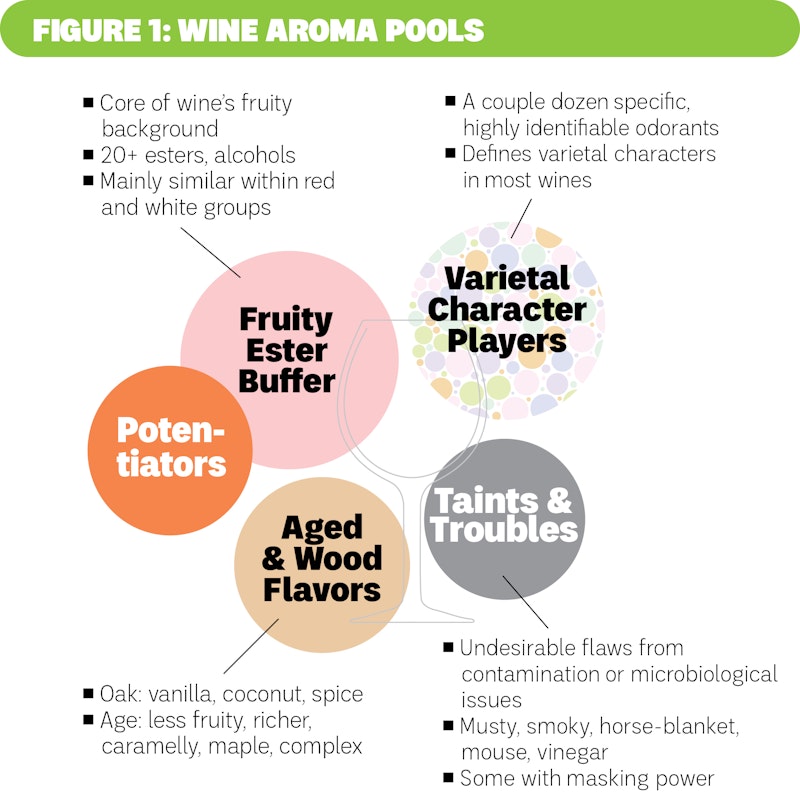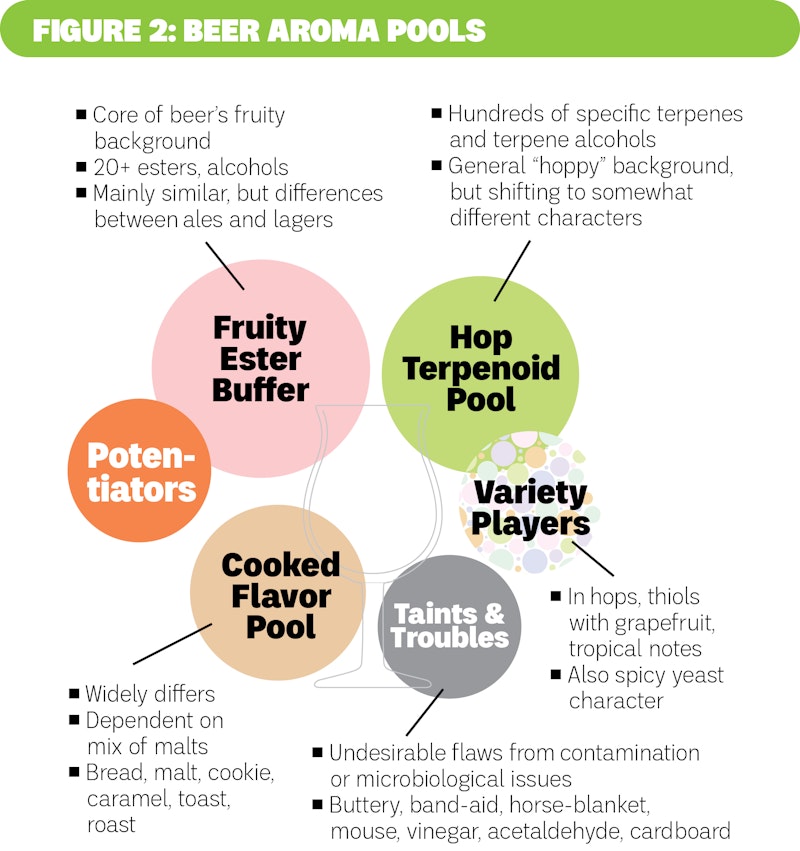Beer is more complex than any other known beverage. No one’s keeping the master list of odor chemicals, but it’s huge. Hops alone contain more than 1,000 terpenoids that feature citrus, floral, and other aromas, besides other chemicals. In malt, Maillard and other browning processes create hundreds more. Fermentation and maturation create a third family of aromas, also enormous—and yet, there are more. Add them all up, and you’d get a number far higher than the widely quoted 600 to 1,000 or so odor chemicals in wine.
That enormity makes it difficult to comprehend. Where to begin? Without the comforting framework of styles, it can be a little hard figuring out where to focus one’s attention. Clearly, we’re not equipped to pick out a thousand or more aroma chemicals from even the most thoughtful nosing of a beer.
Here’s the question: How does our olfactory system make sense of such complex stimuli without overwhelming our neural resources?
Recently, I came across a fascinating article about wine that really promises to upend the way we think about aromatically complex subjects. To make sense of their research, we have to take a couple steps back and consider how, exactly, we smell things.
How We Identify Aromas
The crucial and mysterious sense of smell is fed by an array of almost 400 different types of olfactory receptors, of which we have varying numbers of copies. While there are exceptions, most receptors are stimulated by more than a single chemical, while most chemicals stimulate more than one receptor type. These responses may be positive, negative, or null, and the responses for each receptor and chemical vary by concentration. For complex reasons, there is also quite a bit of interaction among neighboring receptors, which tend to be responsive to similar chemicals. There is also competition among odorant chemicals for receptors.
Anything we smell creates a specific pattern of olfactory receptor neuron responses. When this pattern arrives at the brain via the olfactory bulb, the brain translates it from a pattern of responses to chemistry to a pattern of meaning. It is this pattern of meaning that the brain actually recognizes from memory and ultimately uses to make decisions.
How the brain does this is still a deep mystery, but one of the key features is that the chemical coding initially generated by the nose is utterly and irretrievably lost when it hits the brain’s olfactory cortex. Scientists call this “configural processing,” meaning that individual sensory input comes together to create a percept—that is, a sensory experience that is different from its components and that is not readily broken back down into them. Smell behaves more like this than any other sense. These configural odors are everywhere in our lives, whether or not we realize it.
The best example I can think of is cola. This ubiquitous soft-drink flavor is composed of many terpenoid-rich botanicals, including lemon, lime, orange peel and blossom, coriander, cinnamon, and nutmeg. Combine them in the right proportion, and cola magically appears to tickle your nose. While those who work with this every day might be able to tease out the threads, I defy any mere mortal to do so. Cola is not the simple sum of its parts.
Synergies and Malcontents
One of the more revealing ways to study the smells of foods and drinks is to analyze their aroma constituents as well as their relative intensities compared to their known detection thresholds. For each compound, this results in an odor activity value (OAV). An OAV of 1 is where the threshold meets the quantity present, meaning it’s probably detectable and therefore relevant to the overall odor.
To study a complex mix such as wine, these values are used to create a “model” wine aroma. Single chemical compounds are blended according to the original analysis, which is then compared to the original. If it’s the same, the next step is to start removing aroma chemicals, to find which of them really matter.
A typical wine may contain hundreds of aroma chemicals, but typically only a couple dozen are needed to create a convincing facsimile. In this study of fruity esters in wine, researchers included 14 ethyl esters; only six of those had an OAV greater than 1. What they found was remarkable. They were able to remove every ester except one and still maintain the same fruity character as long as they bumped up the quantity to match the original intensity. Amazingly, this took five times as much of the replacement ester (in OAV terms) as the original components. As a group, the esters were so resilient that scientists termed them a “buffer.” Even though many of the original esters were far below threshold values, they were strongly interacting—demonstrating superadditivity, a kind of synergy. Put simply, they were more than the sum of their parts.
Nor was this the only type of nonlinearity. They discovered destructive interactions between desirable aromas such as fruitiness and problem odors such as smoke, green pepper, barnyard (Brettanomyces), and mold, which is a well-known aroma wrecker in many situations. These interactions give wine off-flavors a potency far beyond their own aroma intensities. The same thing happens in beer.

Charts ©2023 Randy Mosher, From Your Tasting Brain: How It Works and How to Use It
Figure 1 sums this up: Wine has a pool of self-amplifying fruity odors and a second pool of mostly spice and cooked aromas derived from wood, especially in reds. An unruly set of varietal aromas are different enough from fruity esters to stand out from them, although some can simultaneously enhance fruitiness. Finally, there are bad actors sowing destructive mayhem.
Aroma Pools
Is beer odor structured similarly? It seems like it may be. Since the fruity esters in both wine and beer derive from yeast—shockingly, wine gets little of its fruitiness directly from grapes—each has a similar fermentation flavor pool. Both beer and wine contain a grab-bag of varietal impact compounds.
While wine has a pinch of cooked flavors derived from toasted wood, it’s nothing like the scope and centrality of the cooked flavors in beer, which originate from kilning and other heat-processing of grains. That obviously varies widely by recipe, but it’s always a strong presence. It’s also known that many Maillard components—especially at the light-and-malty end of the spectrum—can enhance other aromas and even the sweet taste in products as diverse as cheddar cheese, cereal, tomatoes, and wine. A chemical called maltol is said to be able to enhance just about anything. However, these same compounds can be potent maskers of bright, fruity flavors, and they can contribute to beer staling.
Then, there are hops and their vast pool of terpenoids. In wine, a handful of terpenes are relevant to varietal character, especially in so-called “aromatic whites,” but in beer they are a main attraction. These are difficult chemicals to get a grip on in terms of aromas. While they are generally floral and citrusy, we typically don’t encounter them by themselves—although, with some practice, we can learn to identify a few of the more abundant ones: geraniol (rose, geranium), linalool (coriander, lavender), and beta-citronellol (lemongrass, citronella). Yet there are many others in the mix. The result is beer’s generally “hoppy” background.
So far, there’s nothing so dramatic in the beer literature as the wine re-blending experiment I mentioned above. However, there is evidence for reinforcing interactions between closely related terpenoids such as geraniol, linalool, and beta-citronellol. There are also known interactions between different classes of hop-aroma compounds. These include, for example, a character-bending effect between monoterpene alcohols such as linalool and branched-chain fatty acids such as isovaleric acid that may be responsible for the melon character in some hops. It’s also well known that hop thiols, besides having their own distinctive aromas, are strongly reinforcing each other as well as terpenoids and other odor chemicals. Asked if she thinks there is a terpenoid pool in beer similar to the ester buffer in wine, Christina Schönberger, the head of innovation and education for the hop giant BarthHaas, says, “Absolutely, I would support that.”
Toward a Useful Model for Brewing
Among creative brewers of IPAs, it’s no secret that there are a lot of synergies between hop varieties that help them punch above their weight. Unfortunately, it’s difficult to come up with any generalities about this approach.

Charts ©2023 Randy Mosher, From Your Tasting Brain: How It Works and How to Use It
Figure 2 illustrates beer aroma pools. From the perspective of a flavor creator, there are a lot of helpful concepts here:
- First, an ingredient need not be individually distinguishable to have a meaningful effect. Therefore, a number of small contributions may add up to something much more impactful than would be expected.
- Second, these “buffer” pools are very useful in establishing the overall character of a product, but each constitutes a crowd with a “mind” of its own. Sometimes you can manage to shove them one way or another, just a bit, but a smarter strategy is to use contrasting things that can rise above them or enhance certain aspects of them. It’s futile to try to really control them in the naturally fermented products we’re talking about here.
The group of variety players includes positive odors such as hop thiols with their valued grapefruit and tropical notes, but some can have toasted onion/garlic notes. Others can cut both ways. The norisoprenoid beta-damascenone is potently fruity, but its cooked apple and dried fruit can be a stale note in hoppy beers.
As in wine, the taints-and-troubles pool is highly destructive to positive beer flavor, and not just because of their own unpleasant smells. Most are known maskers of fresh, fruity, and hoppy aromas.
As tasters, we love to be able to dissect aromas down to the molecular level, but it’s clear that this is often an unworkable strategy, especially with positive flavors. Sometimes, it’s better to step back a bit and contemplate the mysteries and magic contained in the depths of the flavor pools.
Further Reading
The original research article about wine aroma pools is titled “A New Classification of Perceptual Interactions between Odorants to Interpret Complex Aroma Systems. Application to Model Wine Aroma,” by Vicente Ferreira, Arancha de-la-Fuente-Blanco, and María-Pilar Sáenz-Navajas. It appeared in the journal Foods, published July 14, 2021.

